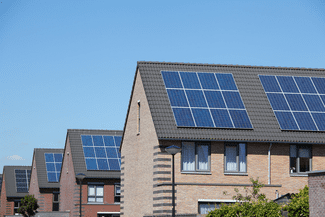How Much Money Can You Really Save by Switching to Solar and Wind Power?
Whether you invest in Tesla panels, new solar shingles, or a mix of wind turbines and panels, there are a ton of renewable energy options that lead to long-term savings for your home.

According to Solar Energy Industries Association, solar has had an average annual growth rate of 50% over the past 10 years in the United States, largely due to the Solar Investment Tax Credit—a 26% tax credit—enacted in 2006. Installing solar is also more affordable now due to community solar options, as well as installation costs dropping over 70% in the past decade.
You might be wondering if switching to renewable energy is cost-effective for your family. While there’s no one-size-fits-all clean energy solution, we spoke to experts to get their takes on how (and why) solar and wind power work—as well as one homeowner who shares why her family chose to make the switch.
Getting Started with Renewable Energy
Solar is the most popular source of renewable energy for homeowners right now. “Solar is growing very rapidly and about a third of all the solar energy deployed today, or maybe a little bit less, is going towards buildings,” says Garrett Nilsen, acting director of the Solar Energy Technologies Office.
The Department of Energy has an excellent guide to getting started with renewable energy for your home that explains how it works, if your home is suitable for solar, tips for installation, and more.
“We have been working to reduce our reliance on non-renewable energy and be better stewards of the environment, in general, for years,” says Elizabeth D’Ascensao, a homeowner from Massachusetts who converted to solar. “We first made the switch to an electric car, and after seeing just how easy a transition that was (and without sacrificing performance, comfort, etc.), we started looking in earnest at solar energy for our other needs.”
Wind power is a little more location-dependent, explains Patrick Gilman, program manager with the Wind Energy Technologies Office in the Department of Energy’s Office of Energy Efficiency and Renewable Energy. “Wind at the residential scale is a little bit different. It’s where it works, it works great, but it doesn’t work everywhere. What we see is, first of all, you need a site with really strong and steady wind.”
Long-Term Savings Investment
The reality is, you’re not going to see a massive cut in your bills right away by switching to renewable energy at home. But you’ll be on the path to significant savings, says D’Ascensao. “We make a monthly payment toward the system itself (roughly the equivalent of paying a utility bill), but eventually we will not have that payment, whereas we’d be paying for electricity…forever.”
Another bonus? The payments won’t go up. “We’re no longer at the mercy of fluctuations in utility costs,” she explains.
Another thing to keep in mind as you’re looking for savings, says Gilman, is to be sure to consider not only a new power source but also how efficiently your home is using energy.
“It’s really important, particularly for the homeowner or the residential level, for people to think about—if they’re looking at solar or wind renewable energy for deployment in their home—that they’re also considering the full picture of how they use energy,” Gilman explains. “And so, energy efficiency has to be part of the discussion as well. Obviously, the cheapest kilowatt-hour is the one you don’t use.”
Your Home Value Might Go Up
Adding renewable energy, such as solar panels, to your home will not only reduce current monthly utility bills, but it can also potentially increase the home’s value by up to 4.1% more than comparable homes with no solar panels, CNBC reports—or an additional $9,274 for the median-valued home in the United States.
“It’s something that’s actually been endorsed by the Appraisal Institute in the United States, such as an income, as a valid way of assessing income for my property,” says Nilsen. You can use this tool to get an estimate of how solar can change the value of your home.
Improvements in Solar Panel Designs
While this won’t have an impact on your savings, if you’re concerned that solar panels are unattractive, know that their look is changing rapidly. You might picture large blackish-blue modules sitting on your roof and cringe. But according to Nilsen, there are other options, which is great news if you’re part of a homeowners association (HOA).
“We’ve funded work in trying to figure out how to make solar more aesthetic,” Nilsen explains, “So, whether it’s changing the look of the cell to look like something slightly different, that’s a bit more aesthetically pleasing, all the way through to figuring out how to put skins over the modules to make it look like anything else but a solar panel. So, it could blend in with your roof, if you are in a HOA that prohibits solar.”
Whether you invest in sleek Tesla panels, are looking at the new solar shingles that just debuted, or are thinking about a mix of wind turbines and panels for your home, there are a ton of options that lead to long-term savings.
Source: Better Homes & Gardens















 Accessibility
Accessibility